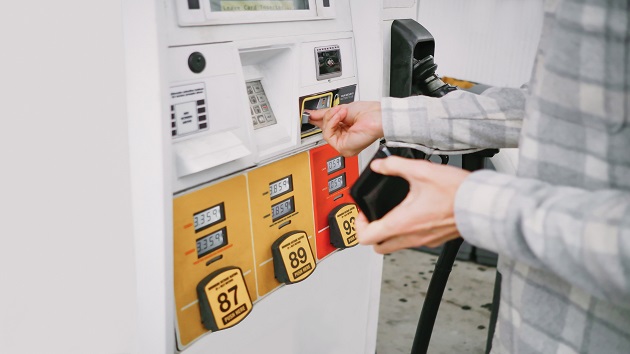Lower crude oil prices and a drop in gasoline demand in the U.S. are starting to put the brakes on rising pump prices. While nearly half of all states, including Oregon, are seeing prices climb again this week, the rate of increase is slowing down. For the week, the national average for regular unleaded slips two cents to $3.66 a gallon. The Oregon average rises four cents to $4.09.
“The national average appears to have reached its spring peak. It climbed to a year-to-date high of nearly $3.67 on April 20 and has ticked down each day since then. The Oregon average is at its year-to-date spring high today of just over $4.09. West Coast prices will likely rise a bit more before peaking,” says Marie Dodds, public affairs director for AAA Oregon/Idaho. “Pump prices had been steadily increasing since late March. Typically, we see a spring peak sometime in May.”
Crude oil prices fell below $80 per barrel last week and have remained in the upper $70s per barrel since then. Oil prices rose above $80 per barrel after the April 2 announcement from the Organization of the Petroleum Exporting Countries and other major oil producers, including Russia, known collectively as OPEC+, that the cartel would cut oil production by just over 1 million b/d through the end of 2023.
“If this trend of crude oil prices below $80 continues, drivers may see falling gas prices,” adds Dodds.
Crude oil is trading around $77 today compared to $81 a week ago and $99 a year ago. In March, West Texas Intermediate ranged between about $64 and $81 per barrel. In February, WTI ranged between about $73 and $80 per barrel. In January, WTI ranged between about $73 and $82 bbl. Crude reached recent highs of $123.70 on March 8, 2022, shortly after the Russian invasion of Ukraine, and $122.11 per barrel on June 8, 2022. The all-time high for WTI crude oil is $147.27 in July 2008.
Crude oil is the main ingredient in gasoline and diesel, so pump prices are impacted by crude prices on the global markets. On average, about 56% of what we pay for in a gallon of gasoline is for the price of crude oil, 20% is refining, 11% distribution and marketing, and 14% are taxes, according to the U.S. Energy Information Administration.
A factor that always puts upward pressure on pump prices in the spring is the seasonal switch to summer-blend fuel. California has an April 1 deadline to switch to summer-blend fuel, while the federally mandated deadline is May 1. The West Coast region often sees prices climb earlier than other parts of the country because of that earlier California deadline. This fuel is more environmentally friendly but more expensive to produce. More info on summer- and winter-blend gasoline can be found at the EPA website.
U.S. refineries often go off-line or have reduced output ahead of these seasonal switchovers so that maintenance can occur. This week, many refineries are returning to service from extensive winter/spring maintenance. The U.S. Energy Information Administration (EIA) said total input rose last week by 330,000 b/d to 16.44 million b/d, putting it above this time last year. More refinery operations will be restarted in the next three weeks, with some planned work extending into June.
Demand for gasoline in the U.S. demand decreased from 8.94 to 8.52 million b/d for the week ending April 14.
This compares to 8.87 million b/d a year ago. Meanwhile, total domestic gasoline stocks increased slightly by 1.3 million bbl to 223.5 million bbl. Lower demand, alongside growth in stocks, would typically push pump prices down; however, elevated oil prices over the past month pushed them higher.
Quick stats
Oregon is one of 22 states with higher prices now than a week ago. Arizona (+14 cents) has the largest weekly jump. Michigan (-12 cents) has the largest weekly drop. Oregon has the sixth-smallest weekly gain.
California ($4.89) has the most expensive gas in the nation for the eighth week in a row. Hawaii ($4.78) is second, Arizona ($4.70) is third, Washington ($4.58) is fourth, and Nevada ($4.27) is fifth, Oregon ($4.09) is sixth, and Illinois ($4.06) is seventh. These are the seven states with averages at or above $4 a gallon. This week 43 states and the District of Columbia have averages in the $3-range. No states have averages in the $2 range this week, same as a week ago.
The cheapest gas in the nation is in Mississippi ($3.13) and Arkansas ($3.23). For the 119th week in a row, no state has an average below $2 a gallon.
The difference between the most expensive and least expensive states is $1.76 this week, compared to $1.75 a week ago.
Oregon is one of 48 states and the District of Columbia with higher prices now than a month ago. The national average is 22 cents more and the Oregon average is 20 cents more than a month ago. Arizona (+49 cents) has the largest monthly jump. Colorado (-8 cents) and Hawaii (-4 cents) are the only two states with monthly declines.
Oregon is one of 49 states and the District of Columbia with lower prices now than a year ago. The national average is 47 cents less and the Oregon average is 57 cents less than a year ago. Nevada (-81 cents) has the largest yearly drop. Arizona (+15 cents) is the only state with a year-over-year increase. A year ago, pump prices were rising rapidly after the start of the Russian invasion of Ukraine.

